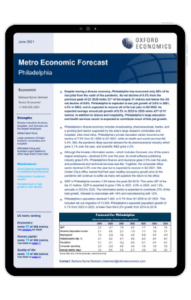US | Metro Economic Forecast: Philadelphia

Despite having a diverse economy, Philadelphia has recovered only 55% of its lost jobs from the nadir of the pandemic. Its net decline of 6.5% from the previous peak of Q1 2020 ranks 33rd of the largest 51 metros and below the US net decline of 5.6%. Philadelphia is expected to see job growth of 3.6% in 2021, 4.2% in 2022, and is expected to recover all of its lost jobs in Q3 2022. Its expected average annual job growth of 0.3% in 2023 to 2025 ranks 42nd of 51 metros. In addition to leisure and hospitality, Philadelphia’s large education and health services sector is expected to contribute much of this job growth.
What you will learn:
- Philadelphia’s diverse economy includes broadcasting, pharmaceuticals, banks, and a growing tech sector supported by the area’s large research universities and hospitals. Like most cities, Philadelphia’s private education sector incurred a net decline of 7.5% from Q1 2020 to Q1 2021, while its health and social services fell 5.4%.
- Although the broader information sector—which includes Comcast, one of the area’s largest employers—declined 8.0% over the year, its small software publishing industry grew 6.9%.
- GDP in Philadelphia remains 1.3% below the peak Q4 2019. This ranks 36th of the top 51 metros. GDP is expected to grow 7.9% in 2021, 4.5% in 2022, and 1.5%, annually in 2023 to 2025.
Tags:
Related Services

Post
Food prices to bottom out in 2024, risks skewed to upside
Our baseline forecast is for world food commodity prices to register an annual decline this year, in aggregate, reducing pressure on food retail prices further downstream. However, we believe the risks to this forecast are overwhelmingly skewed to the upside.
Find Out More
Post
Battery raw material prices to recover
Battery raw materials prices bottomed out last quarter and we think a sustained recovery is looming. Midstream EV battery manufacturing activity has picked up again and inventories have returned to historical levels, suggesting upstream demand for raw materials will also bounce back.
Find Out More